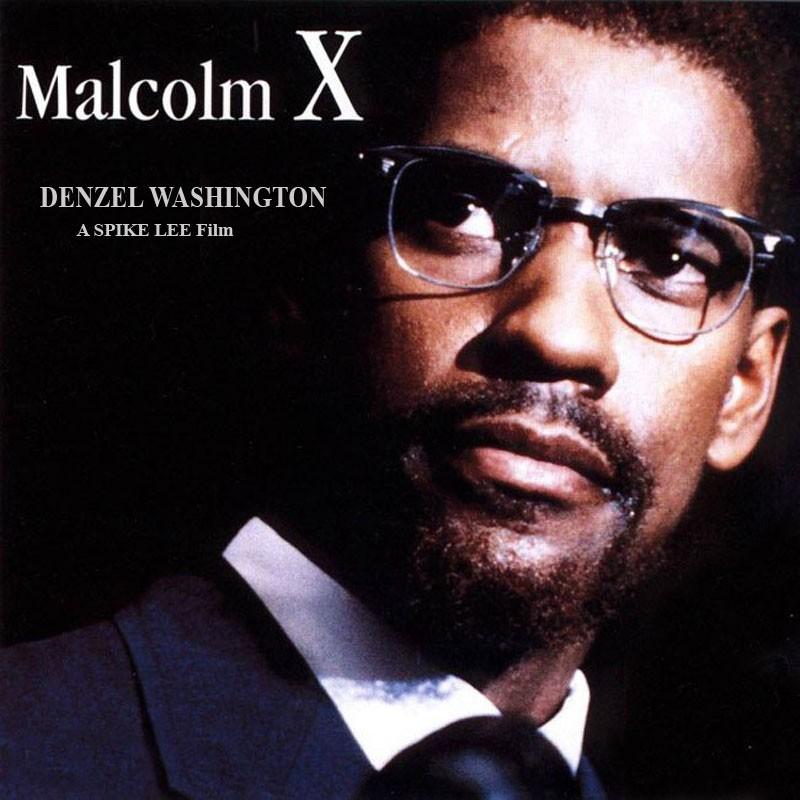Malcolm X is a moving biography of the man of the same name. It spans about half of his life, which explains why the film runs three hours and twenty minutes. The film doesn’t ramble, however; Spike Lee utilizes almost every second to send his message.
For example, there is a long dancing scene early on when Malcolm meets Sophia. At first, I thought there was just too much time spent watching dancing couples. Then I realized that it represented something larger: Malcolm is content in his youth, unaware of the world’s problems. The energy of the dancers contrasts the more serious overtones later in the film.
This is just one example of Lee’s efficient use of time. Surely he realized that the film was so long (and length beyond two hours probably decreases market success), so he only included what was essential.
The film begins when Malcolm (played skillfully by Denzel Washington) is about in his early twenties. Shorty (played by Lee, the director) is slicking back Malcolm’s hair in a barber shop. This becomes a symbol for Malcolm’s subconscious desire to assimilate into white culture. A short time later, we see Malcolm and Shorty running playfully through a park. Lee uses a crane shot to give us an overhead view; this creates the illusion that the characters are as small as children. The crane moves down and reveals them to be adults. Through this, Lee tells us that it is naïve for black Americans to try to be like white Americans. I mention this to highlight Lee’s mastery of the cinematic art form. He adds quite a bit of depth to the film without making it seem overly “artsy” or out of place.
Later in the film, Malcolm gets into crime: he uses cocaine and robs sleeping victims. This eventually results in his and Shorty’s arrest, and they are sentenced to eight to ten years in prison. There, Malcolm meets Baines, a black Muslim man who teaches him the ways of Islam. Malcolm begins to understand the extent of his own oppression and learns to love Allah. Through mail, he connects with Elijah Muhammad, the leader of the Nation of Islam. While in prison, Malcolm learns to shed his last name and replace it with X. His prison experience is his development into adulthood.
Malcolm meets Elijah Muhammad upon his release from prison. This begins his career as a preacher and activist for black rights. His talent as an orator quickly gains him a substantial following. He decides to utilize his new-found power in demonstration to defend the rights of an arrested black man. He leads a march of at least one hundred people to the jail where the man is being held and demands that he receive immediate health care. The group then follows the ambulance to the hospital as a white man exclaims, “That’s too much power for one man to have”. This connects to the jealousy Elijah Muhammad feels, contributing to the theme of a constant power struggle.
Malcolm X continues to grow more powerful in both the black rights movement and the Nation of Islam. Islamic leaders decide he threatens the power of Elijah Muhammad, so they start plotting his assassination. Meanwhile, Malcolm ventures to Mecca and has a “spiritual epiphany”, finally realizing that he is willing to work with white people that are willing to help. When he returns, someone burns down his home, and he attempts to hide from the assassins. His loyalty to the black rights movement compels him to speak at a meeting the following day. The assassins follow him there and end his short, but productive life.
“Malcolm X” is more than a biography about the enormously influential leader of the black rights movement; it is a story about maturation, devotion and loyalty, and the effect of power on the individual. Lee takes full advantage of the cinematic medium to express these themes. His work is supported by impressive performances in the cast. The soundtrack adds richness as well.
The Bottom Line
Malcolm X is worth your three hours and twenty minutes. It tells a fascinating story from history, but also speaks to human nature and individual struggle. It’s rare in modern cinema to see a film that can be considered a work of art. This film certainly qualifies.










